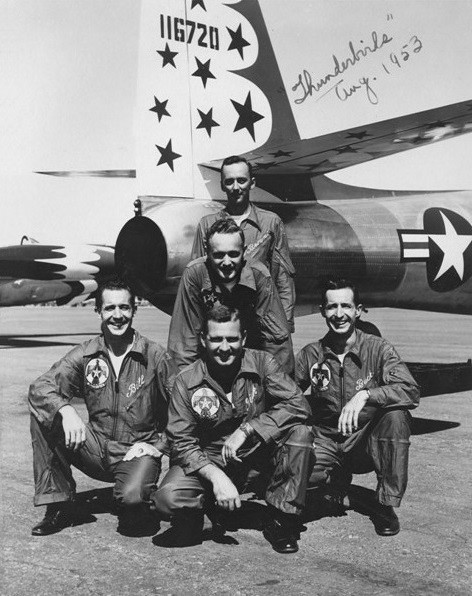
Описание: Republic F-84G-26-RE "Thunderjet" (s/n 51-16720) in the background. LUKE AIR FORCE BASE, Ariz. -- Sixty years ago on May 25, 1953, the 3600th U.S. Air Force Air Demonstration Flight activated. The history of the now famous 'Thunderbirds' began at the end of World War II. The U.S. Army Air Forces' fighter arm only had piston engine aircraft. The first jet fighter was just coming into the inventory. After the war, a number of commands decided to develop teams to demonstrate the capabilities and flying precision of their pilots and new jet aircraft. In 1948 in Europe, Capt. Charles Pattillo, a WWII 352nd Fighter Group fighter pilot, helped organize the U.S. Air Force aerial demonstration team, the 'Skyblazers', where he flew left wing. His twin brother, Capt. Cuthbert Pattillo, flew in the same WWII group until he was shot down and became a prisoner of war. Starting in 1948, he was assigned to the same fighter wing as his brother and also helped organize and fly in the 'Skyblazers'. In August 1952, Charles Pattillo was assigned to Air Training Command's 3600th Combat Crew Training Wing at Luke Air Force Base. The following March, his brother arrived. Catledge, a WWII fighter pilot and POW, also arrived at Luke about the same time as Charles Pattillo to command one of the training squadrons. Capts. Robert Kanaga, William Brock and Robert McCormick were also on base. McCormick had been a member of Air Defense Command's Sabre Dancers demonstration team. First Lt. Aubry Brown arrived at Luke in March 1953 to be an instructor pilot. Both McCormick and Brown were Korean War fighter pilots. Given the large number of aircraft at Luke, flying more than 400 sorties per day, Air Training Command chose the base for its aerial demonstration team. Flying the subsonic, straight-winged Republic F-84G "Thunderjet", Maj. Richard Catledge flew lead. Charles Pattillo flew left wing, and his brother flew right wing. Kanaga flew the difficult slot position. The diamond shape was the team's basic formation. McCormick was the spare pilot and could fly slot. Brown served as the maintenance officer, and Master Sgt. Earl Young handpicked the team's 21 maintenance technicians. Brock served as the narrator and information officer. Three weeks later, they gave their first performance to the chief of staff of the Air Force. Prior to Kanaga's reassignment in September, McCormick moved to slot and the team used the spare aircraft to conduct some solo maneuvers. Catledge selected Brown for that task. The team stayed together until February 1954 when Charles Pattillo became a squadron director of operations and later squadron commander. In May 1954, Brown went back to being an instructor pilot. A month later, Cuthbert Pattillo became a squadron commander. All three stayed at Luke. In the fall, Catledge left for Randolph AFB, Texas. McCormick was the last of the original flyers to leave the team in November 1954. In 1955, to show off the most advanced fighters, the team switched to the swept-wing Republic F-84F "Thunderstreak". In 1956, the team switched aircraft again to the super-sonic North American F-100C "Super Sabre". To simplify maintenance and logistics, the team moved to Nellis AFB, Nev., where it has remained.
Tags:
Поиск и фотоизображения предоставлены компанией Flickr с помощью сервиса Flickr API согласно Правилам пользования сайтом Flick.com и его сервисами. Графические изображения являются публичными, размещёнными их авторами в свободный доступ (Public) и физически расположены на серверах Flickr. Все права на фотографии принадлежат их авторам согласно пользовательскому соглашению сервиса Flickr.com и охраняются законами, регулирующими авторские права.